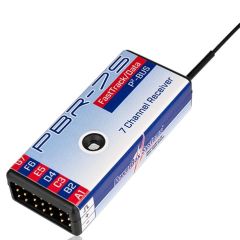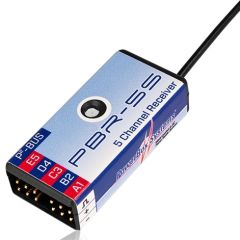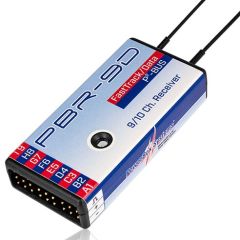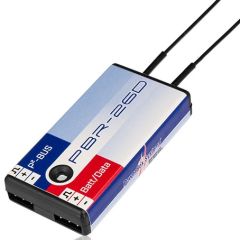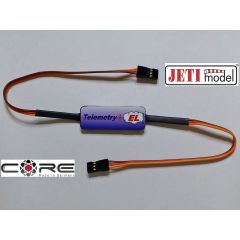Aircraft / Avionics Orders: 800.447.3408 Radio Control Orders: 877.219.4489
CORE 26-Channel 2.4GHz Telemetry Radio, with PBR-9D Receiver, Black
CORE 26-Channel 2.4GHz Telemetry Radio, with PBR-9D Receiver, Black
PowerBox CORE 26-Channel 2.4GHz Telemetry Radio, with PBR-9D Receiver, Black
- 26-channel radio control system
- Extremely secure against interference, genuine redundant 2.4 GHz transmission
- Extremely long range
- Redundant PowerBox power supply system
- High-performance real-time telemetry
- Up to 800 telemetry values per second
- Open bus interface for servos and telemetry
- Aluminum stick units
- Hall sensors for sticks and slider controls
- 20 transmitter controls + 2 optional stick switches
- full-color screen with capacitive touch-screen
- High-contrast screen, legible in sunlight
- Intuitive menu system with Smartkeys
- Integral GPS system
- Linux PC system for every imaginable expansion
Set contents: PowerBox CORE, 1x PBR-9D, case, padded neck strap main adapter, conversion tool, sticker set, screen cleaning cloth, Instruction Quick manual in German and English
PowerBox-Systems manufactures high-quality power supply equipment, and has now been working for more than a year on its own independent radio control system. On the face of it PowerBox may seem a little tardy in introducing a 2.4 GHz RC system, but upon closer inspection it is precisely this belated entry which gives them one unique advantage.
PBR-9D Receiver
This is a nine-channel receiver with two redundant receiver circuits. The unit features a P²-BUS interface for servo and telemetry data, and an auxiliary output which can be configured either as SRXL bus or as channel 10.
During the development of this platform they have not been obliged to make any compromises with regard to compatibility to other systems, and this has enabled PowerBox to create new standards in the sphere of 2.4 GHz RC equipment. Top priority was placed on the CORE’s security and functional stability.
RADIO TRANSMISSION AND POWER SUPPLY
Employs the thoroughly tested frequency-hopping process developed by the Weatronic company. This process is already renowned for its outstanding interference rejection and long range. The CORE’s radio link features integral
redundancy, which is monitored by the receiver. If a fault should develop in a transmitting circuit, then the receiver immediately warns the user of this via telemetry.
The CORE’s incorporates redundant power supplies including two separate Li-Ion battery units rated at 7.2V 3400 mAh. The entire power regulation circuit is also duplicated, a feature currently available only in the CORE. The transmitter’s operating time is around fifteen hours, measured with the screen set to maximum brightness and the system at maximum load.
TELEMETRY
Current telemetry systems are either unable to handle a large number of sensor values, or transmission speed is reduced markedly as the number of connected sensors rises. This is the aspect where the strength of the CORE system is most
evident.
Telemetry handling and transmission can use up to 240 sensors and can be connected to the P²-BUS, each generating 32 data values, and the system is capable of transmitting up to 800 x 16-bit values per second. For the future this level of performance opens up entirely new possibilities, such as real-time servo monitoring in the model. The P²-BUS telemetry interface is accessible to third-party manufacturers so a software update of the sensor system would be sufficient. The configuration and parameter settings are carried out from the transmitter radio link.
LOOK & FEEL FEATURES
- Provides up to 26 channels, each with 4096-bit resolution
- Based on a modern, high-performance Linux PC
- Controlled entirely using the integrated touch-screen
- The software’s basic look and feel are identical to the typical smartphone
- Can be programmed with the minimum of input effort
- Sunshine readable, light touch capacitive touchpad
- Smartkeys (quick-select buttons) provide instant access to Servo Monitor, Screen Lock and other important functions
- Internal data communication is implemented via the CANBUS used in the car and aviation industries for several decades
- High-speed on the screen responds in real time
- All the switches are laid out in a pattern familiar from other High-End systems
- Alcantara leather hand-hold facings fit perfectly in your hands
- Also includes an integral GPS, 9-axis motion sensor, USB and a WLAN socket
- incorporates redundant power supplies including (2) 7.2V 3400 mAh Li-Ion batteries
- Integrated telemetry handling and transmission can use up to 240 sensors
SWAPPABLE GIMBALS & SWITCHES
The physical controls of the transmitter are standard, with the exception of the stick-switches. If these are required, they can be retro-fitted by the customer or by our Service Department. The transmitter’s hardware provides the appropriate sockets. The standard controls are two primary machined aluminum stick units, using Hall sensors with 16-bit resolution and a further four linear controls and features twin ballraces.
The transmitter is equipped with eight toggle switches. The bottom pair are two-position types and all the others are three-position switches. This arrangement can be altered at any time by the user. It would be possible to fit latching switches, or switches with different-length toggles. The inputs for the transmitter controls are designed to offer maximum flexibility. Another new feature in the overall design is the pair of momentary switches to left and right of the primary sticks. These are the perfect choice for controlling wheel brakes, electric starters or smoke pumps.
- Power supply: Li-Ion
- Channels: 26
- Servo signal resolution: 4096 Bit
- Screen: TFT - Touch
- Weight: 1152g
- Temperature range: -30°C to +85°C

